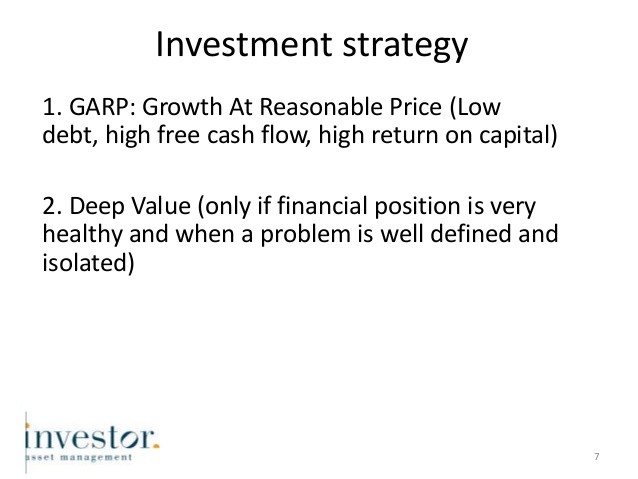Growth at Reasonable Price (GARP) Investing Strategy
Post on: 1 Апрель, 2015 No Comment

As advocated in the value investing strategy, some people enjoy the idea of getting a stock for a bargain price. Others like investing in companies with large growth potential and pursue growth stocks for their portfolio. But for those people who like the ideas presented in both strategies but, find some of the stock picking criteria too severe, then the GARP stock investing strategy might be appropriate.
GARP (Growth at Reasonable Price) is literally a hybrid stock investment strategy that emphasizes picking investments slightly under valued but still expected to have solid earnings growth in the coming years. Many strict value and growth investors are irritated by the perceived ambiguity of the GARP stock strategy. However, GARP investors do seek out specific valuation metrics in order to help them make individual stock selections. But, a degree of personal judgment is also required. Peter Lynch is one of the most famous GARP investors who had an amazing average return of 29% during the years 1977-1990. So how do Peter and other GARP investors pick their stocks?
Growth and GARP investors definitely share a love of studying companies that are expected to continue to grow in the coming years. Growth projections beyond those of other companies within the same industry are welcome by GARP investors but only to a point. Unlike growth investors who tend to pursue the stocks of companies expected to expand revenue, earnings, or both in the 25-50% range, GARP advocates are a little paranoid of such large numbers. Excessive growth projections make GARP investors nervous since they cause higher stock prices and, increase risks of loss should expectations fail to be met. Growth projections in the realistic and affordable 10-20% range make GARP investors more comfortable and willing to make an investment.
Because of their concern for growth, GARP investors also like the P/E ratio valuation metric because, it tells how the earnings compare to the share price. The P/E ratio can be found by taking the current share price and dividing it by the earnings per share (EPS) price, or:
P/E Ratio = Current Share Price / Earning Per Share
For a company to have a P/E ratio. it must at least be operating profitably and therefore have earnings to report. A high P/E ratio. say 40, indicates that the company is currently trading at 40 times its earnings. Growth investors love buying stocks with higher P/E ratios because there are high expectations the company will see significant growth. However, those high expectations come with higher prices for the stocks and GARP investors like to find investments that have been slightly under valued by the market. Higher P/E numbers tend to indicate businesses that are actually over valued, which is why they are not sought out by GARP investors. A P/E ratio in the 10-20 range is more reasonable for a GARP investor as it is less expensive and, less risky than a stock with a P/E ratio of 25 or above. Pursuing stocks with lower P/E ratios is also a tactic of value investors.
GARP and growth investors also tend to prefer businesses with a lower price to book (P/B) ratio. The P/B ratio is used to gauge how much value the market actually places on the book value of the business in question. It is found by dividing the current share price by the book value per share. Or:
P/B Ratio = Current Share Price / Book Value per Share
Where
Book Value per Share = Book Value (Assets Liabilities) / Outstanding Shares
GARP investors look for a lower P/B ratio as that tends to indicate greater value. Companies with a P/B ratio that is below the average for the industry are especially prized by GARP investors since it indicates a larger potential for profit when the market corrects itself and values the stock properly.
While the P/B ratio is used to gauge the relative value of a business and help determine if its stock is under or over valued, the PEG ratio is another favorite valuation metric used by GARP investors to assess growth potential in relation to the value of the company. It is calculated by dividing the P/E ratio by the projected growth in earnings of the company:
PEG Ratio = P/E ratio / Projected Growth in Earnings
For the GARP investor, a PEG ratio of 1 or less is a good indicator that the company warrants further analysis. For example, a company with a P/E ratio of 15 and a projected growth in earnings of 25%, or 15/25 equals a PEG ratio of 0.6 and, would be considered a good investment by most GARP investors. While a 1 or less is desired, companies with a PEG ratio of around 0.5 are considered better as they have good growth potential but, are also slightly under valued Growth at a Reasonable Price!
Indeed, GARP investors seek a balance between value and growth that can seem a little confusing to those unfamiliar with this stock investment strategy. They are not interested in outstanding future growth rates or exceptional bargains sought by growth or value investors. A sound balance between growth potential that is realistic and attainable while also looking for slightly undervalued stocks can be a great recipe for sustained profit with minimal risk.
A careful and studied analysis of the financial statements, projected growth in earnings, and valuation metrics like the P/B and P/E ratios are necessary for GARP investors to pick the right stocks for their portfolio. While every GARP investor ultimately customizes a formula that works best for him/her, there is an ordered process that helps investors choose stocks meeting the GARP criteria for Growth at a Reasonable Pace.














